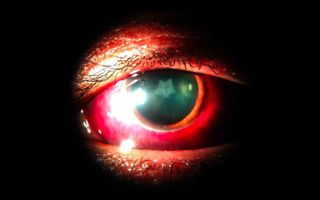A Punch to the Face Left a Man Starry-Eyed — Literally

When a man in India took a fist to the left side of his face during a fight, he may have temporarily seen stars. But when the 36-year-old sought medical care two days after the brawl, it was his eye doctors who saw stars — namely, a star-shaped cataract in the man's left eye, according to a recent report of his case.
The man had developed what's known as a "rosette cataract" in his left eye, according to the case, which was published online Nov. 28 in the journal BMJ Case Reports. This means that the cataract, or clouding of the lens of the eye, had a star-like or flower-like appearance.
Cataracts are more common in older adults, because as people age, proteins found in the lens of the eye can clump together and blur vision, according to the National Eye Institute. But when a younger person develops a cataract, it's typically because the person experienced some sort of physical injury to the eye or head. ['Eye' Can't Look: 9 Eyeball Injuries That Will Make You Squirm]
In the man's case, he was involved in a fistfight and was punched on the left side of his face around the temple area and not directly in the eye, said lead case report author Dr. Rohan Singh, who treated the man at the Government Medical College and Hospital in Chandigarh, India. Singh is currently a corneal immunology fellow at the Massachusetts Eye and Ear Infirmary in Boston.
The man developed the rosette cataract because the physical impact of being hit in the face generated shock waves that traveled through the bones in his temple and into his left eye, Singh told Live Science. These shock waves disrupted the usual arrangement of fibers, or proteins, found in the lens, eventually causing an "opacification," or clouding, of the lens into a rosette or star-like pattern, he said.
Very rare occurrence
Rosette cataracts, especially ones that form the first couple of days following trauma, are very rare, Singh said. In the man's case, his first symptoms, which included redness, pain and progressively worse vision in his left eye, began 6 to 7 hours after he got socked in the face.
Over the next two days it became harder and harder for him to see out of his left eye, so he went to an ophthalmology clinic at his local hospital. Doctors performed a specialized eye examination and spotted a rosette cataract in his lens with five distinct "petals." (Singh told Live Science that rosette cataracts with as many as 10 "petals" have been reported in the medical literature.)
Sign up for the Live Science daily newsletter now
Get the world’s most fascinating discoveries delivered straight to your inbox.
However, the cataract isn't visible to the naked eye — you need special equipment to see it, Singh said, and so the man didn't know it was there until he went to the doctor. Still, people with a rosette cataract will be aware that something is wrong even if they can't see the problem, because they'll experience pain and blurred vision in the affected eye.
Singh noted that the man's cataract would've continued to grow in size had he not sought medical treatment. And because of the location of the cataract in the man's eye, it would have eventually caused more symptoms, including decreased vision and a sensitivity to bright light, he noted.
To treat the man's eye, the doctors performed surgery to remove the cataract and implant a new lens. A week after the surgery, he had 20/20 vision once again in his left eye.
- 27 Oddest Medical Case Reports | Weird Medical Cases
- Here's a Giant List of the Strangest Medical Cases We've Covered
- 10 Things You Didn't Know About You
Originally published on Live Science.
Cari Nierenberg has been writing about health and wellness topics for online news outlets and print publications for more than two decades. Her work has been published by Live Science, The Washington Post, WebMD, Scientific American, among others. She has a Bachelor of Science degree in nutrition from Cornell University and a Master of Science degree in Nutrition and Communication from Boston University.
